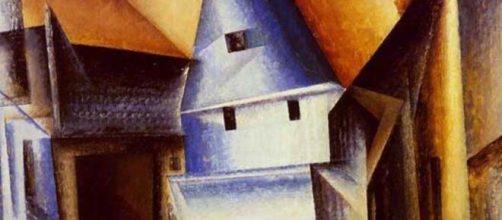Windows. They pop up in painting in so many meaningful ways throughout art history that it’s a wonder they don’t have their own categories like still life, landscape, and portrait.
A look through a diner window to show solitary figures hunched over a counter – "Nighthawks" by Edward Hopper – is a view of alienation in modern America.
Moviemakers have also paid attention to windows. One that bears on today’s column – "Secret Window" (2004) – is an eerie tale about hallucinations, based on a Stephn King story.
Shades of Stephen King
This movie came to mind after learning of a retrospective of the Expressionist painter Lyonel Feininger.
He had a fixation on windows, too. (More about that in a moment).
Feininger’s retro ends this month in Frankfurt, Germany, and while exhibit literature doesn’t mention his interest in windows, it’s plain to see in the work where everything looks viewed through a broken window.
Although he was an expressionist intent on conveying inwardness, Feininger’s focus was not on people. He often used buildings, picturing city streets by breaking through their surface reality with sharp angles, like broken window glass.
“Gelmeroda I,” named after the town where he first began to use buildings as his means of expression, shows a disquieting mood with his fragmentation of the street.
This was painted before the rise of Nazism, that forced him to leave with his Jewish wife for the U.S.
The work suggests foretelling.
Even the few times that Feininger painted people, he went inside of them, too. In “The Bicycle Race,” he shows the intensity of the racers by slicing through the space with an angular, shard-shaped color, as if you’re looking at the cyclists through broken window glass.
But it was the built environment where Feininger found his best means of expression. It’s no wonder that architect Walter Gropius, founder of the Bauhaus School that combined art and architecture, appointed Feininger the first “Bauhaus master.”
Feininger speaks for himself about his fascination with windows in a letter to his wife Julia, cited by art historian Wolf-Dieter Dube in his 1985 tome “The Expressionist”: “Even when I was a little boy in the country, I loved windows.
There will be a whole cycle of work in it. I don’t suppose that I shall ever represent human subjects in the normal sense in my pictures.”
Then, as if to excuse his focus on buildings, Feininger added: “But on the other hand, humanity is the only thing that moves me in everything. Without warm feelings, I can’t do anything.”
By way of explaining his fixation on windows, Feininger told of an incident in his childhood, recounted by art historian Ernst Scheyer.
One summer, while his parents were on tour (his father was violinist and composer Karl Feininger and his mother was the singer Elizabeth Feininger), Lyonel was left behind with friends who had a florist shop on Third Avenue in Manhattan.
Seeing ghosts
Overwhelmed by the scent of funeral wreaths, he sat in the open doorway and watched the trains go by overhead (the Third Avenue Elevator Train). He saw the faces in the windows as ghosts and began to draw them through the train windows.
And that’s pretty much where Stephen King’s “Secret Window” comes in.


